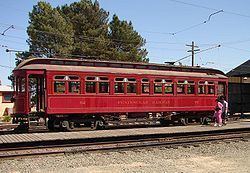Dates of operation 1906–1934 | Length 146,450 m | |
 | ||
Track gauge 4 ft 8 ⁄2 in (1,435 mm) standard gauge Successor Southern Pacific Transportation Company | ||
The Peninsular Railway (known to locals as the Pin) was an interurban electrified railway in the U.S. State of California in the United States of America. It served the area between San Jose, Los Gatos, and Palo Alto, comprising much of what is today known as "Silicon Valley". For much of its existence it was a subsidiary of the Southern Pacific Railroad.
Contents
History
The Peninsular Railway was incorporated in January 1906 as a subsidiary of the Southern Pacific in response to calls for an interurban line from San Francisco to San Jose. In addition to the line to Los Gatos, branches were also planned to extend to Alviso, Oakland and Lick Observatory. However, due to the Colorado River flood of 1905 (which created the Salton Sea), many of the rails to be used for this construction had to be rushed to the Imperial Valley to rebuild the Southern Pacific line between Los Angeles and Yuma, Arizona. Therefore, only the lines connecting San Jose, Palo Alto and Los Gatos were constructed, and interurban service did not exist between Palo Alto and San Mateo. Another attempt to complete this line came in the next decade, but construction was again delayed by a scarcity of steel rails, this time due to World War I.
Before the Peninsular Railway had built any track or started running interurban operations, F.S. Granger and J.W. Rea, who owned the San Jose Los Gatos Interurban Company, sold their tracks to the Pin to avoid competing with a company backed by the Southern Pacific. The original Pin tracks were from several other already existing interurban companies, such as the Alum Rock Railway Company, the Peninsular Railroad, and the Santa Clara Interurban Railroad. Some of the Peninsular Railroad and Alum Rock Railway trackage in San Jose became owned by the San Jose Railroads and were never a part of the Peninsular Railway. The trackage that the Peninsular Railway built itself was the line to Los Gatos through Campbell, the line along Stevens Creek Road to Cupertino, the two lines along the Mayfield cutoff from Cupertino to Mayfield, and Cupertino to Los Gatos, the spur to Congress Springs from Saratoga, and part of the line to Alum Rock Park. All of the lines were replaced by bus service by the late 1930s.
By 1931, the system was operating 34 streetcars on 91.1 miles (146.6 km) of track.
Electric passenger service between San Jose and Palo Alto began on March 5, 1910 and ended on October 1, 1934.
San Jose
By 1920, the sixty-eight-mile system had several main tracks originating in San Jose.
San Jose to Cupertino
Downtown to Monta Vista via Stevens Creek Road (now Stevens Creek Boulevard)San Jose to Los Gatos
via several county roads and San Jose-Los Gatos Road (now Bascom Avenue and Los Gatos Boulevard)San Jose to Los Gatos
via Saratoga-Santa Clara Road (now Saratoga Avenue) and Saratoga-Los Gatos RoadBerryessa (North 10th Street and Madera Avenue) to Alum Rock Park
using dedicated right of way parallel to Berryessa Road and Penitencia CreekPalo Alto
The Pin also operated several local lines in and near Palo Alto, California:
Mayfield - Palo Alto
From what is today the California Avenue train station to the Palo Alto train station, primarily along El Camino RealPalo Alto - Stanford University
From the Palo Alto train depot to Stanford University over El Camino Real and a track leased from Stanford (This track was on the south side of Galvez st, and continued past the Stanford Stadium until Lasuen St, where it continued until turning west along Serra Mall and ending at the Palm Dr loop)Palo Alto - University Avenue
From the Palo Alto train depot to San Francisquito Creek along University AvenuePalo Alto - Waverly Street
From the Palo Alto train depot to Oregon Avenue along University Avenue and Waverly StreetCupertino to Mayfield
along current Union Pacific track and Foothill Expressway. (This route, the so-called "Mayfield cutoff", was also used by Southern Pacific starting in 1908 as part of its steam train passenger service between San Francisco and Santa Cruz.)
Cupertino to Los Gatos
From Monta Vista (Cupertino) to Vasona Junction (Now the junction of California State Route 85 and Winchester Boulevard) along current Union Pacific track
Saratoga to Congress Springs
A branch line from Saratoga-Santa Clara Road and Saratoga-Los Gatos Road to Congress Springs along Big Basin Road
Peninsular Railway car 52
This car is all that's left of the Peninsular Railway. It is currently at the Western Railway Museum, and was one of twelve wooden cars operating for the San Jose Los Gatos Interurban Company. It was renumbered when the Peninsular Railway took over.
